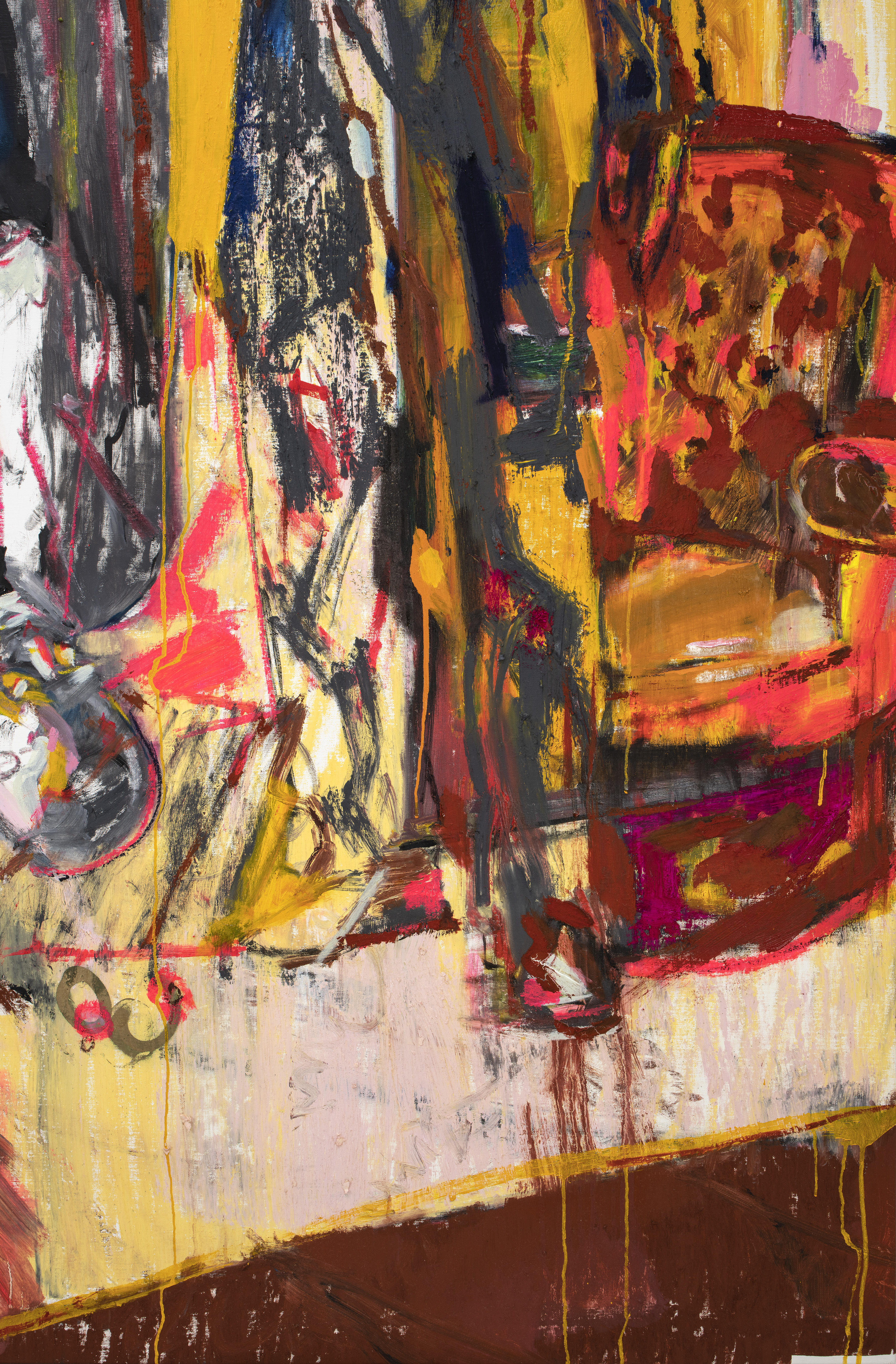The Gathering, The Red Sofa
— Project Bystanders
2020
Pigment Bar on Linen
198 x 152 cm
Private collection
Thresholds of the Impossible: Jaeyeol Han's "The Gathering, Red Sofa"
Jaeyeol Han's "The Gathering, Red Sofa" (2020) stages a profound meditation on the impossibility of settlement in contemporary life, where the most fundamental promise of domesticity—the offering of rest—becomes a site of existential suspension. In this 198 x 152 cm work executed in the artist's signature Pigment Bar technique on linen, Han constructs what Giorgio Agamben might recognize as a "zone of indistinction," where the domestic object encounters its own spatial displacement. The painting's central paradox—a red sofa positioned outside a house while a solitary figure stands, refusing the invitation to sit—articulates the condition of contemporary nomadism not as chosen mobility but as enforced precarity.
Han's compositional strategy operates through what we might call a "trump card dialectic," inverting spatial and temporal relations with the precision of a playing card's doubled imagery. The sofa appears twice: inverted in the upper left corner like a reflected image, and properly oriented in the lower right, creating a temporal short-circuit that recalls Gilles Deleuze's concept of the crystal-image. This structural doubling produces what Deleuze describes as the "indiscernible" unity of virtual and actual, where memory and perception collapse into a single temporal knot. The upside-down sofa functions as the virtual trace of domestic possibility, while the "correct" sofa represents the actual impossibility of its realization.
The phenomenology of non-belonging
The standing figure, clothed and contemplating the ground rather than claiming the offered seat, embodies what Agamben theorizes as "pure potentiality"—the capacity to not actualize, to remain suspended between possibility and realization. This figure's refusal to sit becomes a form of what we might call "impotential domesticity," where the domestic object's function is acknowledged but never fulfilled. The painting thus stages the temporal structure of contemporary precarity, where domestic comfort exists as permanent possibility and permanent deferral.
Georges Didi-Huberman's concept of the "entre" (between) proves particularly generative for understanding this spatial arrangement. The sofa exists neither fully inside nor outside, occupying what Didi-Huberman calls the "visual underside" of domestic space. This liminal positioning creates what he describes as a "symptom image"—a visual formation that reveals the underlying tensions of its historical moment. The red sofa becomes a symptom of Korea's housing crisis, where domestic objects exist in a state of perpetual displacement, never fully settled into stable spatial relations.
The window positioned in the left corner functions as more than architectural detail; it operates as what Didi-Huberman calls a "dialectical image," simultaneously promising interiority and revealing its impossibility. The window's presence suggests the existence of interior domestic space while the sofa's exterior positioning demonstrates the failure of that promise. This architectural element activates what might be called the "architectural unconscious" of contemporary Korean society, where the dream of home persists even as its material conditions become increasingly impossible.
The dialectics of non-settlement
"The Gathering, Red Sofa" achieves its critical power through what we might call the "dialectics of non-settlement"—the simultaneous presentation of domestic possibility and its systematic denial. The painting's sophisticated formal structure, its material specificity, and its engagement with contemporary Korean social reality combine to create a work that functions as both aesthetic achievement and social critique.
The work's theoretical richness emerges from its refusal to resolve the contradictions it presents. The sofa remains outside, the figure continues standing, the gathering fails to occur. This formal persistence of irresolution reflects the broader social conditions that make such resolution impossible. In this sense, Han's painting operates as what Agamben calls a "coming community"—a formation based not on shared identity but on shared impossibility.
The painting's ultimate achievement lies in its transformation of social despair into spatial complexity, creating what might be called a "phenomenology of non-belonging" that speaks to conditions far beyond the Korean context. In an era of global housing crises, climate displacement, and economic precarity, "The Gathering, Red Sofa" offers a visual language for understanding how domestic comfort becomes politically impossible while remaining phenomenologically necessary. The work stands as a testament to art's capacity to transform social analysis into spatial experience, creating images that think through the conditions of their own impossibility.




